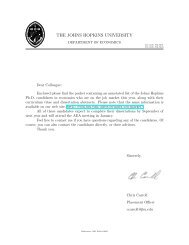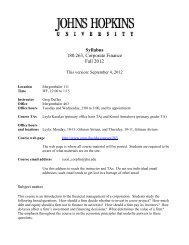WEALTH, DISPOSABLE INCOME AND CONSUMPTION - Economics
WEALTH, DISPOSABLE INCOME AND CONSUMPTION - Economics
WEALTH, DISPOSABLE INCOME AND CONSUMPTION - Economics
You also want an ePaper? Increase the reach of your titles
YUMPU automatically turns print PDFs into web optimized ePapers that Google loves.
non-residential structures, machinery and equipment, consumer durables,<br />
inventories and land. Financial assets are defined as the sum of currency<br />
and deposits, corporate bonds, life insurance and pensions, foreign investments<br />
and equity. The principal liabilities of persons and unincorporated<br />
businesses are consumer and mortgage loans and other loans.<br />
To understand the construction of net assets, it is important to distinguish<br />
between the components of A and their sum. This point is well<br />
illustrated by the treatment of deposits and government debt. Deposits are<br />
a component of A,<br />
which implies that this variable includes inside money.<br />
This, however, should not be the case, since inside money should be offset<br />
by consumer and business loans. Consumer and business loans are a liability<br />
to consumers, either directly or indirectly through their equity holdings<br />
in firms. In the case of government debt, A<br />
includes the government debt<br />
held directly by persons and unincorporated businesses, and then subtracts<br />
the total outstanding stock of domestically held government debt. As<br />
a result, both the government debt held directly by households and the<br />
government debt held by firms (and thus indirectly by households through<br />
their equity holdings) net out.<br />
In the case of the three largest components of non-human wealth,<br />
adjustments are made to improve the quality of the market valuation of<br />
these assets. Equity in the national balance sheet accounts is measured at<br />
“current” value, which is defined as the sum of book value and cumulated<br />
retained earnings. To obtain a market-value measure, the current value of<br />
equity reported in the national balance sheet accounts is replaced with a<br />
measure of the book value of equity that is scaled by the growth rate of the<br />
TSE 300 composite stock price index. Bonds are reported in the national<br />
balance sheet accounts at book value. In the case of treasury bills, this is not<br />
a serious problem, since book and market values do not differ substantially<br />
for these short-term bonds. In the case of federal, provincial and municipal<br />
bonds with a longer term to maturity, the book value series reported in the<br />
national balance sheet accounts is replaced with a market value series<br />
which is constructed by multiplying the original book value series by a<br />
market price index that is constructed using Rose and Selody’s (1985)<br />
19




